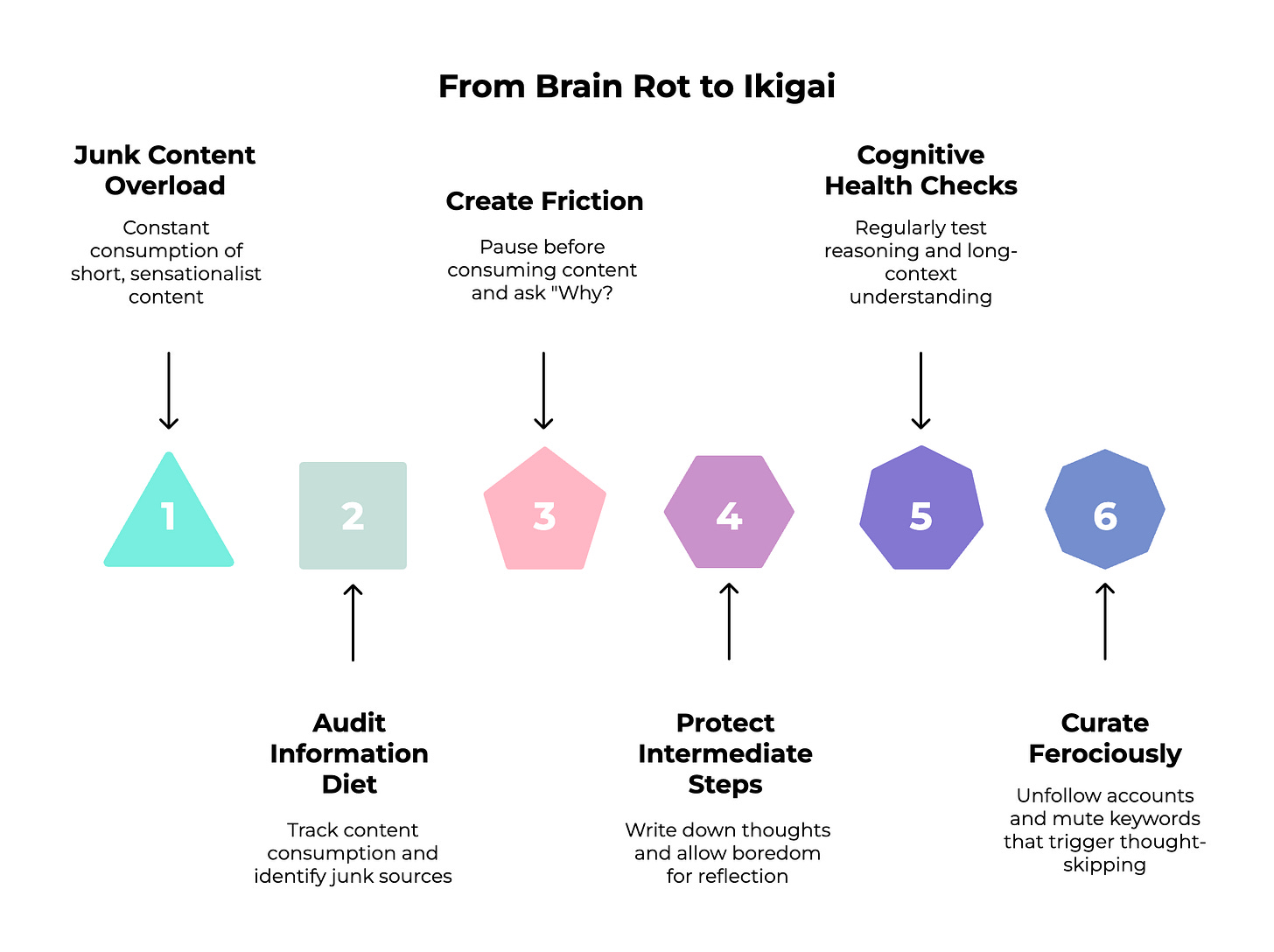The AI Stupiding
TL;DR: Are we getting dumb too? What feeding AI rubbish reveals about our own brains
🌸 ikigai 生き甲斐 is a reason for being, your purpose in life - from the Japanese iki 生き meaning life and gai 甲斐 meaning worth 🌸
You’d think feeding an AI system more data would make it smarter. That’s how learning works, right? More input and knowledge equals better output.
Except researchers just shared something scary… keep feeding large language models the kind of content that floods our feeds; short, punchy, engagement-optimised posts… and they get measurably stupider. Their reasoning abilities decline. Their memory deteriorates. The researchers shared their findings recently in “LLMs Can Get Brain Rot!”
The models start thought-skipping. Jumping to conclusions without showing their working-out. Present them with a logic puzzle that requires holding multiple pieces of information in mind, and they’ll fail tasks they previously managed easily. Feed them pure engagement-bait for long enough, and their performance on complex reasoning drops by nearly 40%.
Worryingly, the damage persists. Even after extensive retraining on high-quality material, the models retain “lingering effects” of all that junk data. The brain rot doesn’t wash out easily.
Is this reflective of what we’ve been doing to ourselves? People aren’t LLMs of course but the mirror analogy feels uncomfortably close to me.
The anatomy of thought-skipping
I’m halfway through writing a sentence when I realise I’ve forgotten what I was trying to say. Perhaps tiredness or distraction, but often it’s because I’ve lost the middle bit. The connective tissue between “I should write about X” and the actual articulation of X and why it matters.
I refresh LinkedIn whilst the kettle boils. Scroll through seven posts but can’t remember a single one a few minutes later. Information passes through me like I’m a sieve, leaving nothing behind except a vague sense of having consumed something.
This is thought-skipping in action.
The researchers classified two aspects of junk content that caused LLM cognitive decline;
M1 (Engagement degree): Short, fragmentary, popular content that is highly liked and retweeted, attention-grabbing but shallow information that fuels doomscrolling.
M2 (Semantic quality): Sensationalist, low-substance content. The “you won’t believe what happened next” stuff. Exaggerations and AI-generated slop that sounds confident whilst saying nothing.
We’re marinating in both, all day long. Our feeds optimise for engagement, not coherence. We need nuanced thinking not hot takes!
And just like the language models, maybe we’re learning to skip steps.
What we mistake for thinking
I used to think my busy brain meant I was always being thoughtful. All that mental chatter, the constant cycling through ideas, the inability to settle… surely that was cognitive activity?
I was confusing overthinking with deep thinking.
Deep thinking requires what the researchers call “intermediate reasoning steps.” It’s the bit where you hold multiple ideas in mind simultaneously, test them against each other, notice contradictions, work through implications. It’s slow. Often messy. Sometimes you end up back where you started but understanding why now.
Overthinking is different. It’s the hamster wheel of the same fragmentary thoughts cycling endlessly. Worry masquerading as analysis. The illusion of mental activity without the actual work of reasoning.
When I audit my own mental load, it’s sobering to see how much cognitive real estate is occupied by information consumed but never properly processed. Headlines I skimmed, opinions absorbed without examining. All this stuff creates that buzzy feeling of being “informed” but doesn’t coalesce into actual understanding.
The LLM research findings
The researchers tested gradients and the results showed a clear dose-response relationship. The more junk in the mix, the worse the cognitive decline. On complex reasoning tasks, models went from 75% accuracy with zero junk down to 57% accuracy with 100% junk. On long-context understanding, the ability to hold multiple threads in mind and find connections between them, performance dropped from 84% to 52%.
Think about your own information diet. What percentage is designed to make you react rather than reflect? Optimised for engagement rather than insight?
If your uncurated feed looks anything like mine, we’re probably running at about 80% junk. Maybe higher.
The models also showed “dark trait inflation”, increased narcissism and psychopathy, when exposed to engagement-bait content. They became less agreeable, more neurotic.
Is it surprising that platforms optimised for engagement are also optimised for outrage? We built systems that reward psychopathy, then wondered why everything feels a bit psychopathic.
Scarily, even after extensive retraining on high-quality content, the models couldn’t fully recover. The brain rot lingered.
This maps uncomfortably well onto human experience.
People who’ve done digital detoxes or committed to consuming only “quality” content report improvements; longer attention span, less anxiety and better sleep… but they also describe a persistent low-level distractibility, a habit of reaching for their phone during any moment of boredom and a default mode of scanning rather than focusing.
The pathways got carved deep. The damage doesn’t wash out easily.
Which means the time to change our information diet is before we’ve marinated too long in the brain rot.
What this means for finding purpose
Finding and maintaining a strong feeling of ikigai requires exactly the kind of thinking that brain rot degrades.
It requires holding multiple threads in mind… your skills, your values, the needs you see around you and the economic realities you’re working within. It requires noticing patterns across your life… what energises you, what drains you, where your attention naturally goes when you’re not forcing it.
It requires the intermediate steps. The working-out. The non-linear process of meaning-making that can’t be rushed or optimised.
It is hard to find your reason for being whilst thought-skipping through life.
Purpose lives in the pauses. In the moments when you’re bored enough that your mind starts wandering in interesting directions. In the space between stimulus and response, where you might ask “why do I believe this?” or “what do I really want?”
When we fill every gap with content consumption, we eliminate the conditions necessary for insight.
Designing against brain rot
If we understand the mechanism “junk content → thought-skipping → cognitive decline”, we can design differently.
I’ve been sketching concepts for social platform use built around wellbeing (ikigai principles rather than engagement metrics). Things like; limited post credits weekly, alerts when you’re pasting AI content, asking you to add why this matters to you specifically, for every sales post, schedule a “gift post” a resource, a lesson, something genuinely useful… and of course after say thirty minutes online, a gentle prompt “You’ve taken in quite a lot, fancy a walk or a brew?”
You don’t need to wait for better platforms, you can start protecting your cognitive health today;
Audit your information diet. Track what you consume for three days. How much is short-form? How much is designed to outrage? How much leaves you with a concrete thought you could articulate to another person?
Create friction before consumption. Before opening social media, ask yourself: “What am I looking for?” If you can’t articulate an answer, you’re probably just filling a gap.
Protect the intermediate steps. Keep a notebook or scrap of paper by your desk. When a thought starts forming, write it down before checking your phone. Let yourself be bored for five minutes without reaching for stimulus.
Build regular cognitive health checks. Once a week, give yourself a reasoning task. Work through a logic puzzle. Explain a complex idea to someone who knows nothing about it. Can you still hold multiple threads in mind?
Curate with ferocity. Unfollow accounts that make you react rather than reflect. Mute keywords that trigger thought-skipping. Your attention is precious; defend it like you would your physical health.
The mirror we made
Large language models don’t have consciousness (probably, *grin*). They’re prediction engines, trained on patterns in text. Which makes them perfect mirrors for revealing patterns we’ve normalised.
We built systems that reward engagement over insight. We optimised for virality over coherence. We filled the internet with junk, then trained both our AIs and ourselves to consume it constantly.
The models aren’t showing us something new. They’re showing us what we’ve become.
A mirror can help you see clearly, once seen you can’t unsee it. And once you understand the mechanism of harm, you can start building immunity.
Brain rot isn’t inevitable. It’s a design choice. We can choose differently.
We can protect the intermediate steps. Guard the space where thinking actually happens. Build platforms and practices that honour human cognition rather than exploiting it.
Your reason for being is waiting for you in the working-out, in the messy middle bits, in the space between stimulus and response.
It’s worth protecting.
Until next time, keep showing your working-out.
Sarah, seeking ikigai xxx
PS - A bullet journal prompt
Create a two-page spread titled “Cognitive Health Check”
Left page - Information Diet Audit: Track your content consumption for three days using this simple notation:
🔴 Red dot = reactive content (designed to outrage/engage)
🟡 Yellow dot = neutral content (informative but forgettable)
🟢 Green dot = reflective content (left you thinking)
At the end of three days, count the dots. What’s your junk ratio?
Right page - Thinking Space Protected: Draw a simple weekly tracker with morning and evening slots. Each day, mark with a ✓ when you’ve had at least five minutes of uninterrupted thinking time (no phone, no input, just your brain doing its thing). Notice patterns… which days are harder? What gets in the way? What bubbles up when you create the space?
Add a small box at the bottom “This week’s intermediate step” write down one thing you’re working through that doesn’t have an answer yet. Let it marinate. Revisit it next week. Practice holding ideas in mind without needing to resolve them immediately.
PPS - An AI reflection prompt
Copy this prompt into your favourite AI tool and spend some time with the results;
“I’ve been reading about how junk content creates “thought-skipping”, jumping to conclusions without intermediate reasoning steps. I want to audit my own thinking patterns.
Here are three recent decisions I made or opinions I formed:
1. [Your example]
2. [Your example]
3. [Your example]
For each one, help me identify:
- Did I do the intermediate reasoning steps, or did I jump to a conclusion?
- What assumptions did I make without examining them?
- What would “showing my working” look like for this decision?
- What questions did I skip asking?
Then suggest: What’s one practice I could adopt to protect the intermediate steps in my daily thinking? Make it specific to my life based on what you’ve learned about me.”
The goal isn’t to judge yourself harshly, it’s to notice where you’re thought-skipping so you can start building different habits… be gentle with what comes up.
PPPS This week’s soundtrack
This essay pairs with “Dumb” by Nirvana… the most meaningful art comes from sitting with uncomfortable feelings rather than thought-skipping past them.
Give it a listen whilst you’re doing your information diet audit. Let yourself feel whatever comes up.




Love this article!
Fascinating article — really thought-provoking. I’ve been using AI with some great productivity results, but I do find it can drift toward bland, same-y output compared to what I could create myself with more time. So I tend to scale back its use and treat it more as an advisor or occasional sidekick than a full-on worker.